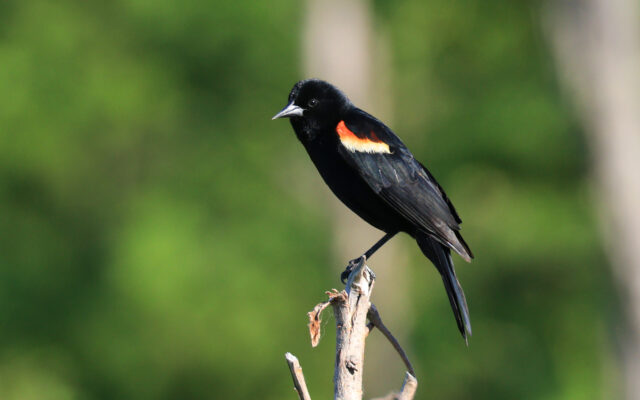
Maine’s early birds are arriving especially early this year
By Bob Duchesne
Time to switch gears and welcome spring. The trickle of migrants has started. It’ll become a torrent soon enough, but why wait? If anything, the early birds are especially early this year.
I was in Medford last week, doing a winter bird survey. Yes, Medford, a small Piscataquis County town west of Howland that’s far enough off the beaten track that even the residents use Google Maps to get home. In rural areas, it’s easy to figure out which homes feed birds. One house featured 20 blue jays in the driveway.
As I counted up the jays, I heard a “conkeree” from behind the trees — unmistakably a red-winged blackbird. It was March 9, a tad early in this area, though they’ve been flocking across the New Hampshire border since the first week of March. Eventually, the bird hopped into the tree above the garage, confirming its identity.
By now, you’re asking what an early returning blackbird can find to eat up here in the still-frosty north. Goodness, you ask all the right questions! Red-winged blackbirds nest in marshes, feasting primarily on insects and aquatic invertebrates, which are good protein sources for developing youngsters.

BLACK BIRD – A red-winged black bird.
For the rest of the year, blackbirds are more interested in the energy they can glean from seedy weeds. On their wintering grounds, they are likely to be found in hayfields and along roadsides, far from wetlands.
Over most of their range, red-winged blackbirds barely migrate. They merely move from the marshes to fields. Some blackbirds winter in Maine, though less commonly anywhere north of Portland. Since they don’t have far to go, they don’t take long to get here.
Red-winged blackbirds and common grackles are among the first birds to return in March. Both have slender, pointed bills, useful for probing for marsh invertebrates in summer. Their bills are a little clumsy for cracking seeds, but they’re sufficient to handle sunflower seeds and softer grains.
That’s why they’ll be showing up at your feeders any minute, and why they’ll leave as soon as easier food becomes available. They are well-suited for handling cracked corn, and I suspect that’s the reason the Medford bird was hanging around with all those blue jays. I didn’t stare into someone’s driveway to find out. That would be kind of creepy.
Not everybody likes blackbirds at the feeder. Pro tip: Blackbirds aren’t fond of perching on feeders. They prefer to feed on the ground. Cleaning up under feeders, and using feeders that minimize spillage, can discourage the hordes that often invade backyards in spring.
While you’re waiting for the rest of the migrants to get here, enjoy the other early signs of spring. Although many weeks will pass before nesting season, crows are getting belligerent toward eagles, hawks and ravens. They’ll do their best to drive off any threat to their future nestlings. It won’t work most of the time, but that doesn’t stop them from trying.
Woodpeckers are pairing up. Male hairy and downy woodpeckers have red patches on the backs of their heads, and females don’t, so it’s easy to notice when mated pairs are hanging out together. Since woodpeckers are now drumming on territory at daybreak, it’s even easier.
Waterfowl have mostly paired up. One good thing about ducks is that breeding males and females look vastly different from one another, making it easy to spot pairs.
Any minute now, American goldfinches are going to start changing color. If you’ve got goldfinches in your yard, put down the paper and go look. Notice those flashy stripes in their wings. That’s going to change, but maybe not how you’d expect.
Goldfinches do a complete molt in the fall, replacing all their feathers. They take on drab colors to make them less obvious to marauding hawks. They also acquire pale wing stripes. The flashing stripes of panicked birds in a flock can make it harder for a raptor to pick out an individual target.
In spring, goldfinches don’t do a complete molt. They retain their flight feathers until the following autumn. The underlying black color of those flight feathers is melanin, the dark pigment that adds strength and stiffness to the feathers of many bird species.
Over the summer, the light-colored stripes wear away, but the black doesn’t. By August, the wings will be completely dark. You can now amuse yourself by watching that change over the next few months.
Finally, spring season is here — or at least it will be, right after mud season.